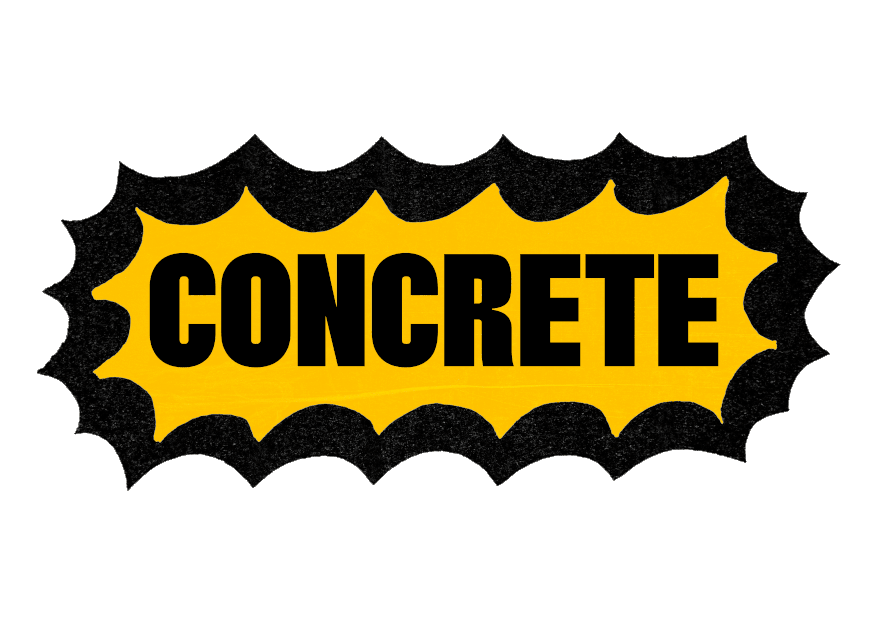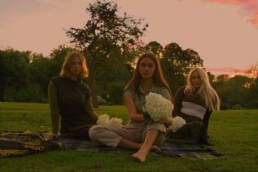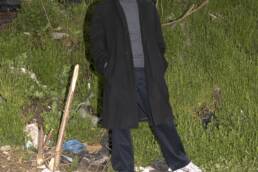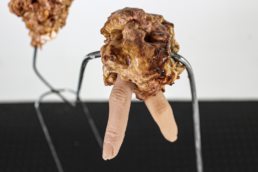Manchester’s own and – barely graduated – Gabriel Kidd has been selected for the New Contemporaries. CONCRETE kept him company while he assembled an installation (just for us!) and discussed gender, gaydar, and goblins.

I: So Gabriel, congrats, you are officially a New Contemporary. How does that feel?
GK: I applied for it not knowing what to expect. It’s very exciting, but I don’t want to get too excited; I need to do something with the opportunity – that feels like the most important thing. Getting it is exciting – but what about in two years? Will I have done anything with it? It feels good for momentum.
I: How do you explain what you do to a person on the street?
GK: I would have said I was a painter a few years ago. Now I’d say archiving. I’m not going at it from an archival perspective – I’m not actively keeping a record of anything – but my work is collections of objects and ideas and putting them together.
I: What type of experiences?
GK: A lot of the time it comes from conversation. That’s maybe why I’m putting this installation together while we talk – I find doing something makes me better at talking about how I do it. So for example a title will come from a story the work is originally from.
I: Can you talk me through what you’re making?
GK: This is a rug from my family, and it’s going to go to the New Contemporaries. I’m going to arrange it with different found objects to create an installation. I use this rug because it has a lot of history. Anything on top of the rug is given context. It was there when I was growing up, then it came with me when I moved out – and a lot has happened on top of it. I like objects that have sentimental value.
I: So what will you put on the rug?
GK: I guess rocks and stuff. *laughs* Objects emit a context. They can give off history, just like instructions on how to use them. Laying out objects does the same thing as laying out words in a poem – in both cases the collected impression is bigger than the components it’s made from. Walking is really important to me because it does so much good for my thinking. I’ll try and pick things up when I’m walking. Saddleworth – where I’m from – has always been a good place to draw ideas from. The landscape is very barren.
I: What’s the basis you can create a larger meaning from?
GK: Experience. I had a conversation with my housemate about the idea of having little people living in the side of your ankles and hollowing them out. How would they actually get on living there? Then I had a time when I had really sore ankles and feet from walking. ‘Maybe it’s them! Maybe they’ve moved in!’ *laughs* That would be the basis for how I’d start a piece of work. I’ll collect bits of bone, rock, maybe even from the walk that hurt my feet, and they all add up into this bigger work which isn’t really about my feet hurting anymore.
I: There is an element of whimsy to your work without it becoming kitsch – whimsy with sex, for example.
GK: That’s really important to me. A sense of humour is really important. I love other people’s art where it feels like there is an inside joke to it. People have described my work as cynical about sex, which I find funny. I don’t want it to get too serious. That’s boring.
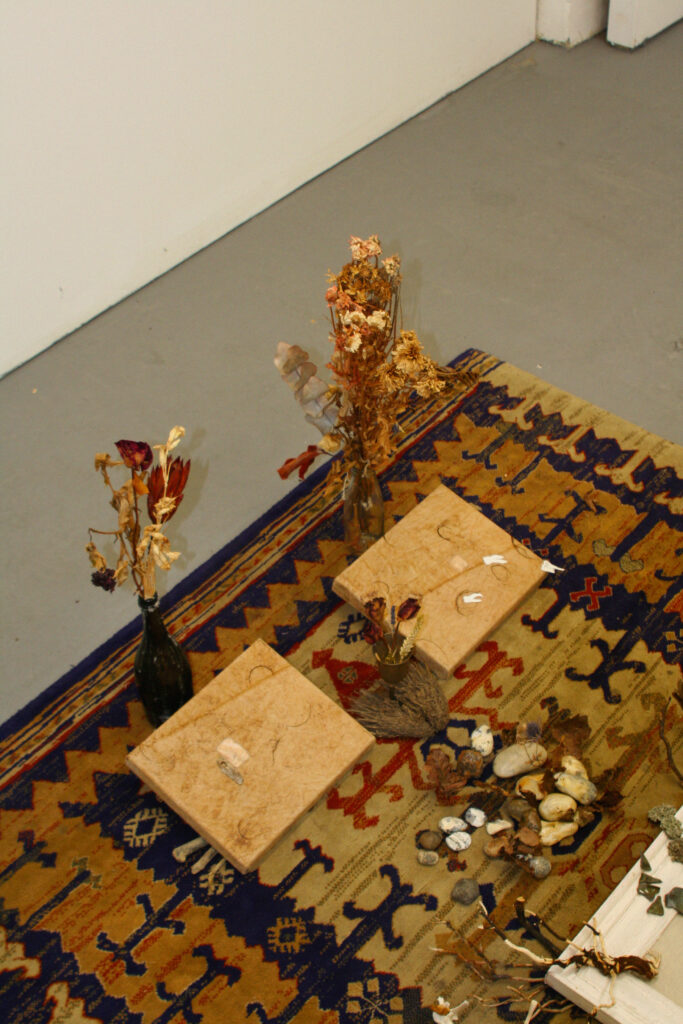
I: Do you feel like you’re a Romantic person?
GK: I think so. Why not? Why can’t life be Romantic, especially when it feels really out of control. Melodrama and Romanticism, together, are a great combination.
I: There is folklore and fantasy to your work, as well, right?
GK: Folklore is really funny to me, which is probably why I gravitate towards it. It has a serious moral, or tone, and the things that happen are very serious and might be gruesome, but are also quite absurd.
I: Have you always liked mediaeval things?
GK: Fantasy and Mediaeval tales have always drawn me in – their villains especially. I used to play a Lord of the Rings strategy game on the computer and I’d always play as a goblin. I loved it – these hideous creatures who interacted with each other in a very slapstick way – and the aesthetic appealed to me too. Nowadays I have a lot of time for fantasy and Monty Python-esque visions of peasants rolling around in the mud. It’s a weirdly fitting and funny context to put modern stories and ways of thinking about the world and relationships into.
I: What are you focussing on right now?
GK: At the minute I’m into Mediaeval story telling. All these terrible things befall the protagonist and the people he meets. Like this one about Perceval – Arthur’s knight, from the 13th century. In the story he assaults a girl, kills his mum by breaking her heart and murders loads of knights. All these events are horrible but his way of moving through it, it reads as almost comedic because of Perceval’s naivety. It’s almost a satire. It’s a good platform to jump from.
I: I know what you mean – a bit like Plebs does with Ancient Rome. What does putting contemporary ideas and ways of being into this context give the work?
GK: I’m able to talk about things that are quite serious. Putting sadness into an aesthetic or context like the mediaeval gives it an irony. Mediaeval stories simultaneously lend themselves to and present obstacles to allegory. It suits it, and it suits parody. The viewer seeing my work and understanding the same narrative as the one I’ve created isn’t what it’s about, necessarily. I want the tone or the character to be communicated. The end product doesn’t have to deliver the same narrative.

I: I think you’re right ways of thinking about sex and gender is completely different now.
GK: Definitely – to even 100 years ago – and the same as with identity. In that direction, it’s a good way to think about how things are now by comparing them to what has happened.
I: I don’t think people change. I think the way society treats people has changed. Gender and sexuality come into that massively – as it does in your work.
GK: I always try to find the queer in something. Even if it isn’t there and it gets into this weird queer theory territory – but what I’m interested in is by looking at things through a queer lens. By placing something next to something else, you can have the feeling of queer without anything actually happening. Shifting between subtleness and being unsubtle is a queer thing.
I: Yeah, something about the covert and the overt symbol.
GK: There is a need to move back and forth, it can feel. A lot of queer people have the ability to cover all that up if they need to… or think they can. I know I get clocked either way, even if I’m wearing jeans, which makes me laugh. I’m looking for ways of presenting queerness in an artistic sense, perhaps in a way that is pretending to not be queer, but is still very obviously queer, some how. Is this queer? This thing I’m making? Nothing overtly says it is. But I think it is, and maybe that’s just because I’ve touched it.

I: It’s subtle. It’s been arranged so perfectly, almost like flower arranging, and that isn’t something associated with masculinity. It’s subjective.
GK: I was reading a book by Jack Halberstam. He wrote Wild Things. He’s looking at where queerness exists outside of LGBTQ identities. He finds it in a lot of places – it’s a big book. One thing that stuck out to me was about absence. What is absence? He breaks it right down, vacuums are still filled with particles. Something that seems empty but is actually full, maybe queerness is like that. Something might be described as ‘queer’ even if you can’t describe it, because they are some how not straight, even if you can’t place it. It’s full of something that isn’t straight and therefore is queer.
I: A bit like ‘gaydar’?
GK: Exactly. What is gaydar? You don’t know for sure but you get a sense you know when you meet someone who is queer. People get annoyed when their gaydar doesn’t work. There is definitely something fun about collecting stuff and then working out how to give it that trait of queerness. Something that is able to not necessarily tell you what is going on but displays the queerness.

I: Talk me through your visual language a little.
GK: Lavender and carnations pop up in my work a lot. I am interested in using the pre-existing language and symbols for queerness, but I guess it’s how you pair that with things which aren’t necessarily associated with queerness. It’s not about finding something new, but about trying to find something a bit more appropriate to me.
I: Why don’t they fit?
GK: If what I’m working through is working through ideas of my own identity, that’s why more on the nose symbols for queerness feel a little bit off. A lot of those symbols are gay symbols. I think there are very specific symbols for trans and gay identities, but I think I struggle to place myself in any of those lines, in any of those terms. So I guess I’m looking for languages that make more sense to me.
Penises appear often in your work. What are you getting at there?
GK: Gosh, I don’t know. I used to try and work them in in a much subtler way. I was doing quite erotic work but didn’t like how on the nose it was so I stripped it back. So maybe I would use something instead as a placeholder – bones, for example, the shape is similar and obviously the world is like boner. The penises don’t always feel sexual to me. It’s humour.
I: That’s fascinating. To me Superbad seems so opposite to your work. You make them look delicate and ornate.
GK: Anything sexy is also funny. I think that is a lot to do with how I think about sex. I have conflicted opinions on it in direct relation to myself. I guess the penis becomes a very immediate way to say ‘this is what I’m talking about’. If a penis I draw looks fragile, I probably feel that way about sex. If they look angry, that might be another way I’m feeling about it. They can be characterful which is a very fun thing to play with. I like the idea of them getting sad about things, and talking more about them as a person than as their genitals. They are a good shape, too;, I like bends and bulges in fabric, rock, and wood, so it becomes another part of that visual.
I: With that in mind, how did you arrive at your materials? At latex and transparency?
GK: The material stuff comes from the context of the material. Latex has a very sexy context, a lot of fetish behind it, but latex also moulds and fits a shape. There is violence in making it, tearing it from surfaces. It is solid but it’s flexible. I like how it changes. I like using stitch and using fabric. My grandma taught me to sew when I was really little. I made Barbie dresses with her and think of that very fondly. When we had lockdown, and had a lot of time in our heads, that’s what I did. It felt so good to return to that, and that’s when the fabric stuff really started. I was doing a lot of natural dyeing with plants, onion. It brings you closer to the material you are working with when you are physically changing it. Painting can feel quite distant.
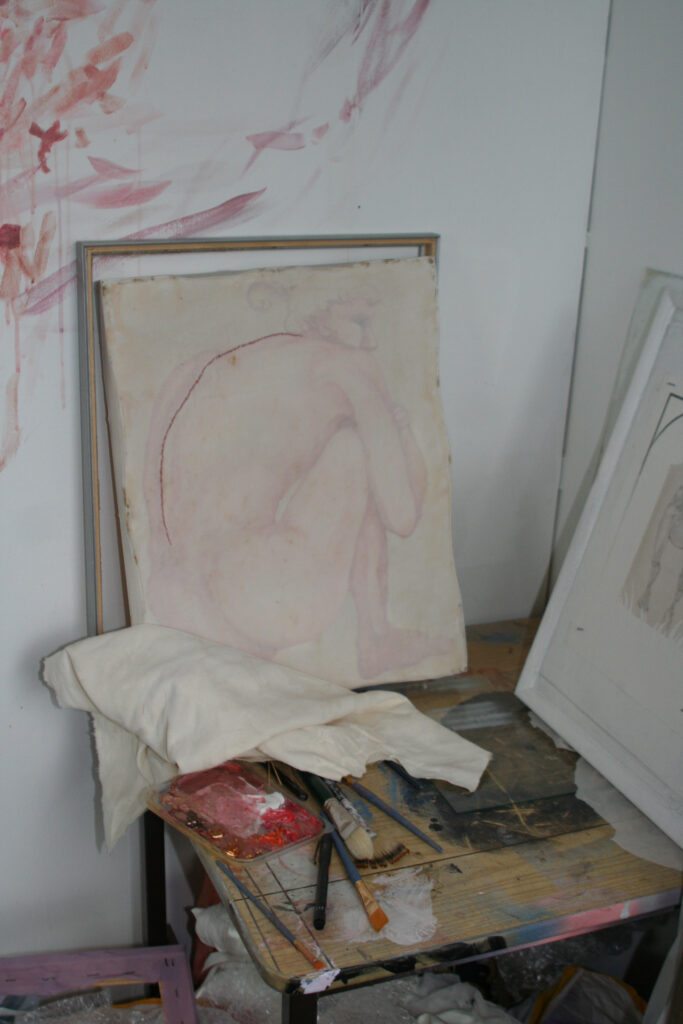
I: What’s something you always come back to?
GK: ‘Bad Gays,’ a podcast which has really changed my perspective of queerness in relation to history and how queerness has existed throughout history. It goes through historical figures who are supposedly gay and talks about the different societal contexts they were in, and how that effected their evilness or badness and how that might relate to their queer identity. Gay Nazis is a good example. There are a few gay fascists, which you don’t really think about, but how does one relate to the other? They unpick these sorts of relationships between power and queerness often. I went to a book signing and I got my book signed and me and a housemate gave them fabric penises. “I’m so sorry,” I said *laughs*. They are very funny, and the podcasts are a joy to listen to. Anything into history I’m about. I love trivia and maps and how things work.
I: What do you dream about?
GK: I had a dream that I was being chased by unicorns. Something was going on with my family in the dream and I was trying to fix it. I was running and the unicorns impaled me and crushed me. *laughs*
I: If you could travel in time, where would you go?
GK: I’d be interested to see what Manchester would look like covered in forest – pre-agriculture. I’d love to go back and see Ancient China. Or to see every single grand palace in the entire world. I’d love to be a lady of the court.
I: What makes you feel accomplished?
GK: When my mum says I’m doing really well. I don’t know if I’m accomplished yet.
I: What’s next for you?
GK: Not much feels fresh right now. I need to put a bit more time into learning stuff. And then go and do some more studying with a masters. There’s a good song by Jenny Hval when she talks about not feeling like she is the main character in life, and how she makes peace with that. I feel like that; maybe I’m the witch that the main character meets along the way. That’s a nice way to think about life. You meet some people who the world seems to revolve a little bit around, I guess I’m –
I: You’re surely not a secondary character?
GK: I don’t feel like a main character. I’m the old man on the side of the road that makes a funny noise and the characters move along. This person has some sort of wisdom and magic about them, and they are someone who was allowed to do what they wanted. You don’t want to be Harry Potter, do you?
I: Fair point.
GK: I want to sit in the forest and whittle spoons instead of doing anything *funny voice* in the art world.

All images are property of Imogen Delbourgo. You can keep up to date with Gabriel Kidd here and here.
